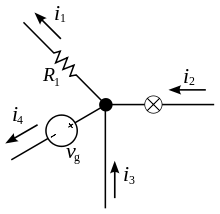Nodes, Branches and Loops
- Branch - represents a single element such as a voltage source or a resistor.
- Node - is the point of connection between two or more branches.
 |
| The different colors in the diagram represents different nodes. |
 | ||||
| An example of a loop. |
KIRCHOFF'S LAW
However, sometimes in complex circuits such as bridge or T networks, we can not simply use Ohm’s Law alone to find the voltages or currents circulating within the circuit. For these types of calculations we need certain rules which allow us to obtain the circuit equations and for this we can use Kirchoffs Circuit Law.
Kirchoff's Two Basic Laws:
Kirchoff's Current Law(KCL)
This is Kirchoff's first law. The sum of all currents that enter an electrical circuit junction is 0. When the currents enter the junction have positive sign and the current that leave the junction have negative sign.
It can be stated as:
 | |||
| The current entering any junction is equal to the current leaving that junction. i2 + i3 = i1 + i4 |
- Kirchoff's Voltage Law (KVL)
This is Kirchoff's second law. The sum of all voltages or potential differences in an electrical circuit loop is 0. it can be stated as:
- It can be stated as:
 |
| The sum of all the voltages around the loop is equal to zero. v1 + v2 + v3 - v4 = 0 |



No comments:
Post a Comment